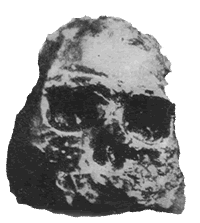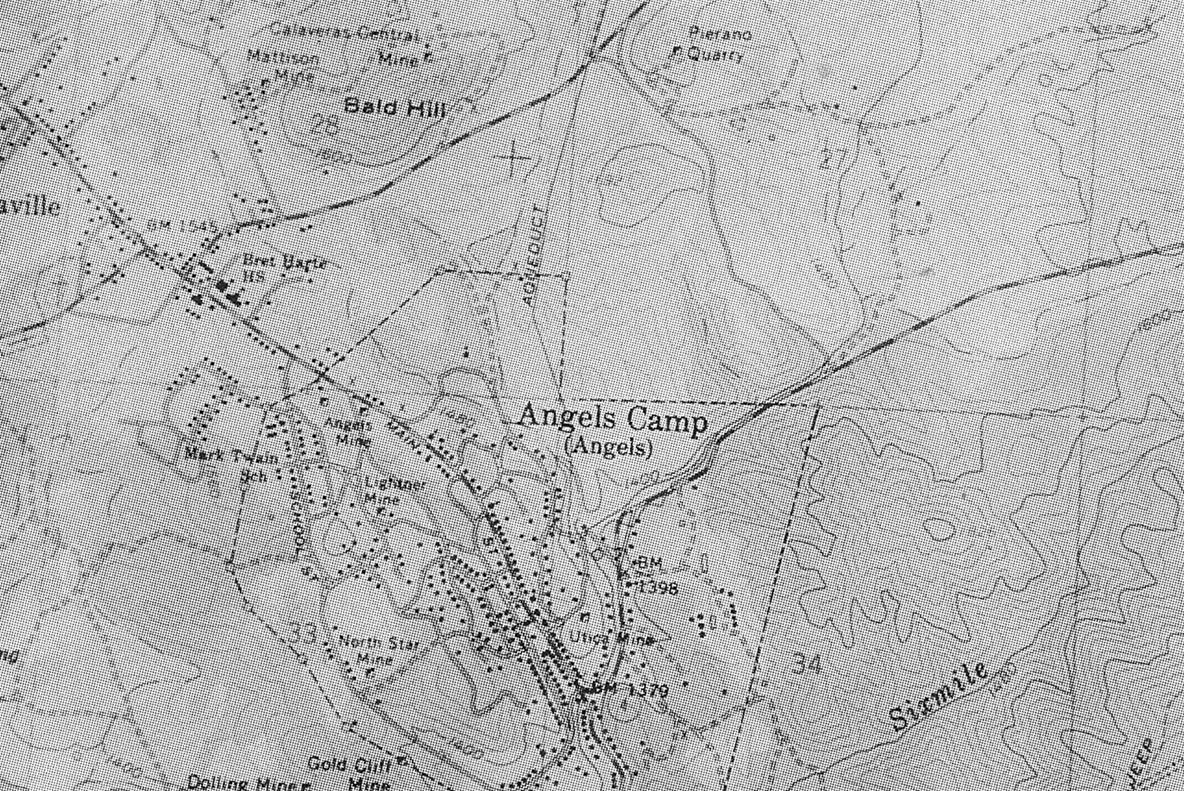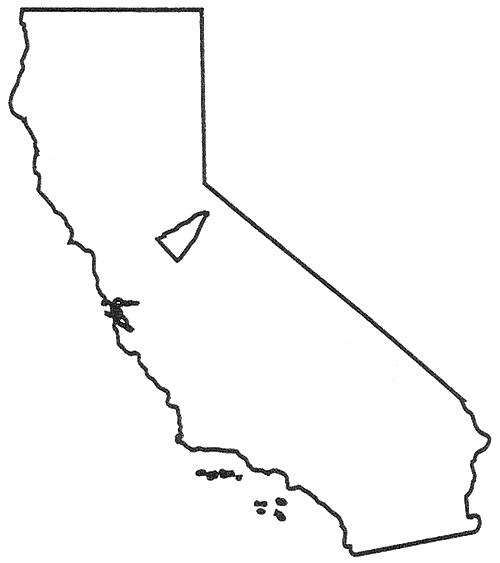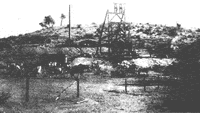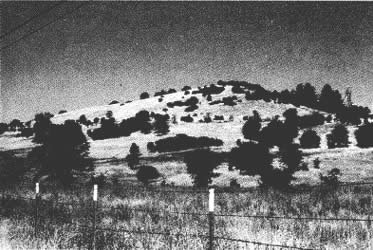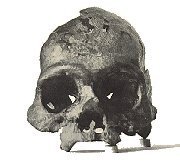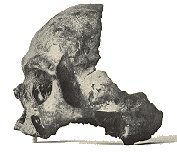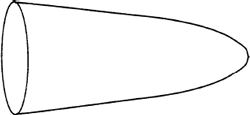The Case for the Calaveras Skull
By Edward C. Lain and Robert E. Gentet
© CRSQ 33: 248-256
This is the earliest known picture of the Calaveras Skull taken before all the original matrix surrounding the Skull was removed. The Calaveras Skull was found in 1866 at Bald Hill near Angels Camp in Calaveras County, California. The original photo dates from sometime between 1866 and 1868 when the skull was transported to Cambridge, Massachusetts, and there thoroughly cleaned and examined scientifically. (From a photo in the University of California library.)
Abstract
The Calaveras Skull was discovered in 1866 in a gold-bearing gravel dated by conventional geology as tens of millions of years older than man's supposed origin. It initiated one of the greatest controversies over American fossil finds of ancient man. All individuals connected with the original find believed it to be genuine, including the famous nineteenth century geologist J. D. Whitney who made it widely known. Later, a ferocious attack by both evolutionists and some religionists branded the skull as merely a trick played upon the unsuspecting finder (Mattison) and the geologist examiner (Whitney). Close examination of the historical facts shows the skull should be taken seriously as one of the most mysterious and probably most significant human fossil finds on the North American continent. The authors believe the Calaveras Skull and hundreds of associated human artifacts have withstood the test of time and constitute remarkable evidences of ancient Man existing in America before the commencement of the Post-Flood Ice Age.
Introduction
On June 18 of 1866, Dr. William Jones of Murphys, California, sent a letter to the state geological survey of California regarding a recently discovered fossil human skull. A Mr. Mattison had personally found this skull in his mining shaft at Bald Hill in Angels Camp, California, 130 feet below the surface, beneath a cap of lava.
The skull had been embedded in auriferous (goldbearing) Tertiary gravels adjacent to a petrified log. This would place the time of the skull before the commencement of the Pleistocene and long before the accepted time of man's arrival on the earth, according to evolutionary geology. Mr. Mattison had first thought it was a root of the petrified log. Later, after some close examination and probing, he was surprised to discover it was a human skull.
Mr. Gabb, a California state paleontologist, asked that the skull be delivered to the State Geological Survey in San Francisco. Dr. Jones complied and the skull was received by the Survey on June 29, 1866. A few days later, the prestigious head of the California Geological Survey, J. D Whitney, who had been out of town at the time of notification, returned to San Francisco and first examined the skull.
Mr. Mattison, the discoverer of the fossil skull, later related to Whitney how the skull had been found. Mattison said he personally dug the skull from goldbearing gravels in his Bald Hill mine shaft in February of 1866. He took it to John Scribner, a store owner and agent for Wells Fargo in Angels Camp. When Scribner received the skull it was
stony material that he [Scribner] did not recognize what it was . . . . Mr. Scribner's clerk cleaned off a portion of the encrusting material, discovered that the article in question was a human skull [not a tree root, as first supposed by Mattison], and shortly after, gave it to Dr. Jones [in nearby Murphys], who was well known in that region as an enthusiastic collector of objects of natural history . . . .When delivered into the writer's hands its base was imbedded in a conglomerate mass of ferruginous earth, water-worn pebbles of much altered volcanic rock, calcareous tufa, and fragments of bones. This mixed material covered the whole base of the skull and filled the left temporal fossa, concealing the whole of the jaw. A thin calcareous incrustation appears to have covered the whole skull when found; portions of it had been scaled off, probably in cleaning away the other material attached to the base (Whitney, 1880, p. 268).
Further Investigations
On July 16, 1866, Whitney read a brief paper about the skull before the California Academy of Sciences (Proceedings of the California Academy of Sciences, Vol. III. 1868. pp. 277-278). In his 1880 book, Whitney (p. 270) makes the following significant comment:
The debris in which the skull was imbedded were not, however, removed, nor any chemical examination made of it, until some two years later, after it had been taken to Cambridge [where, it may be noted, it still resides after nearly 130 years, as this CRSQ paper is being written in 1995].
The site of the fossil skull was visited "several times" (Whitney, 1880, p. 271) by Whitney, the state geologist, and three assistants of Whitney, as well as by several of Whitney's personal friends not connected with the Geological Survey. In the words of Whitney (1880, p. 271):
. . . and to all these Messrs. Mattison and Scribner have given exactly the same statement in regard to the finding of the skull. All of these gentlemen have returned from the place strongly impressed with the idea that there was no mistake, and certainly no intentional misstatement, on the part of either of the principal parties whose names are associated with the find. . . . The skull remained on and near the place where it was obtained for several months after it was discovered; and no doubts were expressed by any one as to the good faith of the parties concerned, until after it had been sent to San Francisco and had been much written about in the newspapers.
Two or three years after the skull's discovery, the San Francisco religious newspaper, The Pacific sent a reporter to the area of the discovery. The reporter ". . . received-apparently-almost, if not quite, exactly the same statements from them which had previously been given to the writer by the same men, and then returned to San Francisco and wrote and published the following: 'Strange memory this, we thought, to retain such minute particulars of such a supposed unimportant discovery, two years before' " (Whitney, 1880, p. 270).
About 1883, three years after the publication of Whitney's monumental book (1880), Dr. A. S. Hudson, of Stockton, California, was reported by William Holmes to have visited Angels, California, and interviewed Scribner and Mattison. In the words of Holmes, Dr. Hudson was convinced after talking with Scribner "that no deception whatever had been practiced" (Holmes, 1899, p. 631).
When Dr. Hudson interviewed Mattison, he showed Mr. Mattison and his wife " 'the figure or cut copied from Professor Whitney's book. . . . Mrs. Matson [Mattison is also known by the name of Matson] at once recognized the picture as representing the specimen in question. It was said the cemented gravel so adhered to it as to fill out the back head and make it look a natural occipital portion' " (Holmes, 1899, p. 631, quoting from Dr. Hudson).
Dr. Hudson's evaluation of Mr. Mattison's character, as reported by Holmes (1899, p. 634), was highly favorable:
seems to be a very honest appearing man. He evidences no disposition to magnify, falsify, or to depart from the correct line of truth.
Figure 1: Shows general location of Calaveras County, California, where Angels Camp is located. This Angels Camp Quadrangle 7.5 Minute Series Topographic map of the Angels camp area shows the precise location of Bald Hill located just to the northeast of Murphy Grade Road and Highway 59. Notice that the Mattison Mine is shown on the western side of the hill. The top of Bald Hill is given as 1765' and the base around 1560-1600' so the relief is about 175'. Murpheys, California is located a few miles further up Murphy Grade Road to the northeast of Bald Hill. Map published (1962) by the United States Geological Survey.
More than One Skull Involved
One of Dr. Hudson's purposes was to investigate the accusations made by those who opposed Whitney by saying the Calaveras Skull was a deliberate hoax. The information regarding this "hoax" interpretation is convoluted. The varying accounts conflict as to who perpetrated the hoax and upon whom the supposed hoax was played. What emerges from all these conflicting accounts is that a joke-not a hoax-was played on someone (certainly not Whitney) at a later date. The joke involved a different skull from the famous Calaveras Skull found by Mattison.
The later joke apparently was an idea hatched when someone read a humorous poem written by Bret Harte entitled "The Pliocene Skull" which made fun of the skull. The poem was first published July 28, 1866, only 12 days after Whitney first officially alerted the scientific world at the California Academy of Sciences of the Calaveras Skull find.
Figure 2: Contrast of how Bald Hill near Angels Camp looked in 1907 (left picture) compared with 1995 (right picture). Mattison's discovery of the Calaveras Skull in his mine at Bald Hill was in 1866. The mine was located further to the left on the other side of the hill from the mine shown on the extreme right of picture b. See topographic map (1) for more precise location. (The 1907 Renier Mine picture is courtesy Angels Camp Museum; Nancy Carson, Curator. 1995 photo by Robert E. Gentet.)
Some believed the "joker" skull-not the Calaveras Skull found by Mattison-originally came from a cave burial before being planted in the mine. In reviewing the circumstances of the Calaveras Skull and the later "joker" skull, John C. Merriam (1910, p. 157) writes:
If the Calaveras skull came from a cave, it still remains to show how it finally passed into Whitney's possession as a relic from the auriferous gravels. In this connection several interesting items of information have come to light. One of these seems to show that even if a joke had been played upon the miner, Mattison, this particular joke had failed to reach the geologist Whitney. Some years ago Professor F. W. Putnam exhibited a small photograph, showing the skull in nearly the condition in which it was first seen by Whitney, to residents of Angels Camp who claimed to have been concerned in putting the joker skull into Mattison's mine, and was informed that this was certainly not the skull which they had put in the shaft [emphasis ours]. In this connection Dr. Sinclair has recently shown that skulls from the locality at which the jokers were supposed to have obtained the specimen used to fool Mr. Mattison are buried in a matrix quite unlike that which covered Whitney's specimen.
This seems to be the origin of the claim that the Calaveras Skull was from a recent American Indian burial which someone had found and planted in Mattison's mine as a joke. However, it is important to note that from the very beginning of the discovery of the Calaveras Skull, everyone acknowledged the Calaveras Skull was truly a fossil. (In fact, the skull is so completely fossilized that only a trace of organic matter remains in the skull thereby preventing direct dating by Carbon-14.)
Calaveras Skull an Uncommon Human Fossil
G. F. Becker (1891, p. 194) of the U.S. Geological Survey pointed out that:
A rhinoceros jaw from the same horizon contained more than two and a half times as much phosphate as carbonate, and was thus much less completely fossilized than the human bone. Truly fossilized human bones are very great rarities, and to suppose that the miners were not only successful in 'salting' the mine with human bones, but that they procured truly fossil bones to do it with, requires a painful stretch of the imagination. But, further, when the skull was found a mass of gravel indistinguishable from the surrounding material adhered firmly to it and remained thus attached until, long afterwards, Dr. Jeffries Wyman removed it in Cambridge, Massachusetts. Hence the miners must have found it, if at all, in a formation similar to or identical with the auriferous gravels. The supposed joke would therefore be quite without point [emphesis ours].
Another individual who personally examined the Calaveras Skull soon after it was discovered was William H. Dall. On January 10, 1899, he reported the following to the Academy of Natural Sciences of Philadelphia: "The evidence has generally been regarded among scientific men as convincing and sufficient" and that "no sufficient reason had been adduced for doubting the genuine character of the skull and its original situs [location] below the lava." (Dexter, 1986, p. 367).
In 1899, Vice-president Thomas Wilson of the American Association for the Advancement of Science also defended the skull's genuineness. In his address before the AAAS, Wilson quoted from an earlier address at the same meeting by Putnam who said "That man was on the American continent in Quaternary times, and possibly still earlier, seems to me as certain as that he was in the Old-World during the same period." (Dexter, 1986, p. 367).
In addition to these men, other noted men such as L. G. Yates (1887), E. T. Newton, President of the Geologists' Association (1899), and W. O. Ayres (1882) were all in agreement with Whitney that the Calaveras Skull was not a hoax and was originally embedded in the auriferous gravels at the time of their deposition before the Ice Age.
In the words of George F. Becker (1891, p. 195):
I find that many good judges are fully persuaded of the authenticity of the Calaveras skull, and Messrs. Clarence King [first Director of the USGS], O. C. Marsh, F. W. Putnam and W. H. Dall [see our earlier quote from him] have each assured me of his conviction that this bone was found in place in the gravel beneath the lava* [his footnote here says: "This statement is made by permission."]. Dr. Alfred R. Wallace, too, who has seen at least some of the auriferous gravels and table mountains, in speaking both of the implements found and the Calaveras skull, stated that these remains 'present all the characteristics of genuine discoveries' [Here Becker has another footnote which reads: "Nineteenth Century Magazine, Nov. 1887, p. 667. See also 'Darwinism,' 1889, p. 456."].
Figure 3: Contrast these views of the Calaveras Skull after being cleaned and examined with the one at the beginning of this article. The skull is not "primitive," or in the words of Dr. Wyman who gave the craniological peculiarities of the skull in Whitney's book (1880, p. 273): "That the skull presents no sign of having belonged to an inferior race." If the fossil were truly found in the Teritary auriferous gravels beneath Bald Hill, then evolutionary theory would require it to be very "primitive." Furthermore, full extent of the condition of the skull when found as a fossil is revealed. In the words of Whiteney: "The skull ... Had been broken, and broken in such a manner as to indicate great violent and protracted motion .... The appearence of the skull was something such as would be expected to result from its having been swept, with many other bones, from the place where it was origionally deposited down the shallow but violent current of a stream, where it would be exposed to violent blows against the boulders lying in its bed. During this passage it was smashed, and fragments of the bones occuring with it were thrust into all the cavities where they could lodge. It then came to rest somewhere, in a position where water charged with lime salts had access to it, and on a bed of auriferous gravel" (Whitney, 1880, p. 272)
Figure 4: C. J. King, the first director of the USGS, found this broken pestle in 1869 in the gold-bearing gravels under Table Mountain near Tuttleton, California less than 50 miles from the discovery site of the Calaveras Skull. King failed to publish his find in 1869 and it was much later in 1891 before it was published in the literature, not by King, but by fellow geologist G. F. Becker. However, the implement was presented to the Smithsonian Institution on Jan. 20, 1870, and was U.S. National Museum. Cat. No. 9237 until it was broken and the museum discarded it in 1935. Becker reported that:
"This mass [of stone—the broken pestle] he [C. J. King] forced out of its place with considerable difficulty on account of the hardness of the gravel in which it was tightly wedged. It left behind a perfect cast of its shape in the matrix, and proved to be a part of a polished stone implement, no doubt a pestle . . . It is difficult to imagine more satisfactory evidence than this of the occurrence of implements in the auriferous, pre-glacial, sub-basaltic gravels" (Becker, 1891, pp. 193-194). Miners reported finding hundreds of pestles, mortars, and other types of human artifacts in the Tertiary gravels in a span of over 30 years during the last half of the nineteenth century (Gentet, 1991).
Whitney Familiar with Cave Skulls
There were those, Blake (1899), Hrdlicka (1907), Sinclair (1908), and others who contended that the Calaveras skull was nothing more than a modern Indian cave skull. Could Whitney have been fooled in this manner? The evidence would indicate "no." First of all, Whitney was familiar with California cave skulls, as shown by Moratto (1984, p. 305):
Long ago, Whitney (1867) removed a number of crania from the Cave of Skulls (Cal-29), west of the Stanislaus River near Abbotts Ferry. Like the bones from Mercers and Moaning caves, these calcium carbonate-encrusted skulls reposed on the cave floor and had not been buried deliberately.
This clearly shows that Whitney was familiar with cave skulls in the area and would have been very unlikely to have confused the Calaveras Skull with a cave specimen.
In support of Whitney's truthfulness and scientific accuracy, no less an opponent than Ales Hrdlicka confirmed in 1907 that differences existed between the original condition of the Calaveras Skull and nearby cave specimens. Though Hrdlicka argued that the Calaveras Skull was a cave specimen, he nevertheless made the following significant statement: "None of the cave skulls [taken by J. S. Hittell from caves in Calaveras county in 1857] showed any adhesion of gravel" (Hrdlicka, 1907, p. 25). If the Calaveras Skull were originally from a cave deposit, then why did it have gold-bearing gravel adhering to it?
Hrdlicka (1907. p. 27) also acknowledged that "It is known that animal fossils with somewhat similar coating have been recovered from ancient sands or gravels." Hence, Hrdlicka acknowledged that fossils can receive a stalagmitic coating in a location apart from a cave setting, even though he vigorously fought the idea that the fully human Calaveras Skull was from the pre-Ice Age Tertiary deposits in this area and therefore much too ancient according to evolutionary-based thinking. In conclusion, Hrdlicka (1907, p. 28) stated the following: "A mass of gravel, bones, etc. adhered to the base of the [Calaveras] skull when discovered. But this was not firmly solidified and could be removed without injury to the bone." This statement, taken with the earlier one acknowledging that "none of the cave skulls showed any adhesion of gravel," shows that even the most adamant opponent, Hrdlicka, saw something unusual about the Calaveras Skull.
Cave Theory Origin Stems from Evolutionary Bias
The belief that the Calaveras Skull originally came from a cave deposit stems from a tenacious belief in the theory of evolution, as shown by the following quote from Merriam (1910, pp. 154-156):
The scientists who have investigated the history of the human race have accumulated a great volume of evidence indicating the close relationship of physical man to an ancient group of large brained animals including the existing apes and monkeys, and have traced the evolution or geological history of the human type in the Old World step by step from ape-like forms up to the present man . . . The sudden appearance of highly developed man in America at the time the auriferous gravels were being deposited would be entirely contrary to the laws of evolution with which our history is in accord elsewhere . . . The writer's attention was first attracted to the question of auriferous gravel man by coming into contact with several persons of high standing who knew definitely of stone implements being obtained from deep gravel mines since the completion of Whitney's studies [emphasis ours]. Note the acknowledgement that human artifacts were found even after Whitney's 1880 comprehensive report.] At that time a list was compiled which included about a dozen apparently well-authenticated instances of occurrences of human remains in the auriferous gravels. The problem taken as a whole seemed to the writer to represent as remarkable a case of absolutely contradictory evidence as ever appeared in science or in law [emphasis ours]. On one side men with high reputations of veracity gave affidavits to the effect that they had personally seen human bones and relics taken from undisturbed layers in supposedly ancient formations. On the other hand, scientists claim that such occurrences are impossible [emphasis ours] . . . The writer has also been unwilling to suppose that the miners of California are more inclined to play practical jokes or that the scientists of the West were more easily fooled than those in other portions of the world or that the word of the average man with reference to scientific matters is less reliable here than elsewhere.
It only becomes "impossible” when the theory of man’s evolution and of his supposed late arrival in the geological record is assumed and all valid evidence to the contrary is therefore rejected.
Carbon-14 Dating and the Calaveras Skull
A recent attempt to date the Calaveras Skull was done by R. E. Taylor and others at the Radiocarbon Laboratory, University of California, Riverside (Taylor, Payen, and Slota, 1992). It should first be kept in mind that the Calaveras Skull itself could not be dated by C-14 directly because it lacked sufficient organic material. The actual human bone dated by Carbon-14 was said to be one of several fragments found in association with the Calaveras Skull. It is not known whether this associated bone is from the same individual as the Skull, but Whitney (1880, p. 268) acknowledged that fragments of human bones were found associated with the Skull when material covering the face and base was removed.
Taylor and others (1992) attempted to establish the C-14 age of the bone fragment by assuming that it originally came from a local cave deposit and was a plant. Note what is said (Taylor et al., 1992, pp. 271-272):
The carbonate matrix encrusting the bone (UCR- 2157C) had a 14C activity equivalent to an apparent age of 2,170 ± 60 14C years BP [Before Present]. If we assume that a correction for the initial 14C activity for carbonates in this environment [an initial cave environment is here assumed for the bone] would be similar to the 710 years that has been reported for carbonates from nearby (about 7 km) Moaning Cave (Broecker et al. 1960), then a reservoir-corrected 14C age for the carbonate matrix removed from the skull would be about 1,500 (+100) years. The inorganic carbonate fraction of the bone sample yielded an age of 1,260 ± 210 14C years B.P. (ICR-2161 A/AA-1878) and the total HCl-insoluble organic fraction an age of 740 ± 210 14C years B.P. (UCR-2161 B/AA- 1879).
After obtaining three different C-14 dates, two for one of the bones said to be associated with the Calaveras Skull and one for the matrix in which the associated bone was found, and after adjusting for needed corrections due to an assumed original cave origin, Taylor et al. (1992) concluded:
The 14C age exhibited by an organic fraction of the Calaveras human metatarsal bone (UCR-2151B) indicates an age of less than 1,000 years. The AARdeduced age [Note: amino-acid racemization is a non-radioactive method of dating objects] for the Calaveras human metatarsal bone indicates a somewhat older age-about 4,000 years. In light of the problems with the AAR method for bone, we suggest that, in this case, the 14C-based data probably more accurately reflect the age of the bone. We interpret the overall weight of the dating evidence to indicate that the age of the bone tested, and by extension, the Peabody Museum Calaveras skull, to be late Holocene in age-probably younger than 1,000 years [all emphasis ours].
Since the calculations were based upon the fundamental assumptions of an original cave burial, we believe even the calculated dates obtained for the bone associated with the Calaveras Skull are most likely invalid. As shown throughout this paper, there appears to be no real evidence that the Calaveras Skull ever originated from a cave.
We realize that others firmly believe the Calaveras Skull to be a hoax. (It is significant that the article title by Taylor et al. calls the Skull the "Piltdown Man" of the New World). But, the Carbon-14 date of "probably younger than 1,000 years" (p. 273) for the associated metatarsal bone becomes invalid because unlike cave skulls found in the area, the Calaveras Skull was acknowledged by all the original researchers to have been found embedded with gravels.
Age of Auriferous Gravels Critical
The presence of any datable Carbon-14 material associated with the Calaveras Skull (whether adjusted for supposed cave environment or not) indicates a time frame quite different than demanded by the accepted geological time scale. A future CRSQ paper by the authors will more closely examine the geological setting of the auriferous gravels from which numerous human remains and artifacts have been discovered. This future paper will assign a post-Flood deposition and erosion time frame for the Cenozoic here, mainly in a catastrophic setting.
In further corroboration that the Calaveras Skull was not originally from a cave environment, we have the following first-hand account by Ayres (1882, pp. 853-854):
. . . Wherever it might have first been found it surely was embedded in the auriferous gravel and it had been become so embedded at the time the gravel was originally deposited. You say that is a bold assertion? How do you know? I will tell you. I know it because the skull told me so [emphasis ours]. I saw it and examined it carefully at the time when it first reached Professor Whitney's hands. It was not only encrusted with sand and gravel but its cavities were crowded with the same material. And that material was a sort-a peculiar sort-a sort which I had occasioned to know thoroughly. It was the common cement or dirt of the miners, that known in books as the auriferous gravel . . . It is not easily imitated. No skill possessed by Mr. Mattison or anyone else could have been sufficient to give the skull the characters which it had when I saw it. It is most certainly no fabrication. But it has been said that it is a modern skull which has become encrusted after a few years of interment. This assertion however is never made by anyone knowing the region. The gravel has not the slightest tendency toward an action of that sort. The skull would either decay and waste away or it would remain unchanged and added to this comes in the fact that the hollows of the skull were crowded with the solidified and cemented sand in such a way as they could only have been only by its being driven into them in a semi-fluid mass. A condition which the gravels have never had since they were first laid down. Let the skull tell its own story and believe what it says because it brings its own proof. Whatever age belongs to the gravel . . . belongs to the Calaveras Skull entirely irrespective of the question of honesty or dishonesty in the alleged finder [emphasis ours]. Wherever he found it, I believe its age to be beyond cavil.
Thus, we also dispense with any thought that the Calaveras Skull was originally a cave specimen later planted in the mine below Bald Hill to fool Mattison or anyone else. Those who examined the skull in its original condition said that it had, without question, come from the gold-bearing gravels.
Other Human Remains Found in the Gravels
Another matter often overlooked by those seeking to discredit the Calaveras Skull is the fact that numerous other human remains have been reported as having been found in the auriferous gravels. Whitney in 1880 makes mention of numerous human, fossil remains in his book The Auriferous Gravels of the Sierra Nevada of California. It now bears repeating Whitney's reports of some of these finds. The Calaveras Skull was only one of many human remains found in the gravels during last century's digging by gold miners. Numerous "jokes" or outright lies would have to be involved in these other cases, and there is no basis for such a conclusion. Some of these human remains date prior to the discovery of the Calaveras Skull in 1866 and the great controversy it generated. These earlier finds are also strong indication that the Calaveras Skull is no fluke of the fossil record in that area.
Whitney (1880, p. 264) writes:
Soon after the writer's communication to the American Association for the Advancement of Science at the Chicago meeting, in 1868, of some of the principal facts connected with the discovery of the 'Calaveras skull,' and when that remarkable relic had begun to be talked about a good deal, he was informed by Dr. J. Wyman that there was in the Museum of the Natural History Society of Boston a small fragment of a skull, which he had identified as being human, and which bore the following label: 'From a shaft in Table Mountain, 180 feet below the surface, in gold drift, among rolled stones and near mastodon debris. Overlying strata of basaltic compactness and hardness. Found July, 1857 [This would place it about 9 years before the discovery of the Calaveras skull]. Given to Rev. C. F. Winslow by Hon. Paul K. Hubbs, August, 1857.' It was also soon ascertained that a similar fragment of a human skull existed in the Museum of the Philadelphia Academy of Natural Sciences, with a similar label. And it appeared that Rev. Mr. Winslow divided the specimen given him by Mr. Hubbs between the two societies in the manner indicated. In Volume VI. of the Proceedings of the Boston Natural History Society, page 278, under the head of October 7, 1857, is a communication from Rev. Mr. Winslow sent with the skull fragment, from which the following extract is made (date not given): 'I sent by a friend, who was going to Boston this morning, a precious relic of the human race of earlier times, found recently in California, 180 feet below the surface of Table Mountain . . . My friend Colonel Hubbs, whose gold claims in the mountains seem to have given him much knowledge of this singular locality, writes that the fragment was brought up in paydirt (the miner's name for the placer gold-drift) of the Columbia Claim, and that the various strata passed through in sinking the shaft consisted of volcanic formations exclusively.
Whitney then makes the statement that "this find evidently excited no attention at all." (Could this lack of excitement be at least partly due to the fact that 1857 is two years prior to the publication of Charles Darwin's book on evolution and the revolution it caused and therefore the 1857 find tended to not ruffle any evolutionary feathers?) Whitney, however, pursued the matter when he heard of it and ended up with a full report of the find. Whitney's investigation persuaded him that the find was genuine and originated in the ancient gold-bearing gravels: "The evidence seems very clear, in all respects, so far as the fact of the occurrence of human remains in the strata underlying the Table Mountain basalt is concerned. Unfortunately the piece of skull preserved is too small to be made the basis of any craniological investigations" (1880, p. 265).
Furthermore, Whitney (1880, p. 266) records:
In the Proceeding of the Boston Society of Natural History, Vol. XV p. 257, under date of January 1, 1873, will be found a communication of Dr. Winslow's relating to another discovery of human remains in Tuolumne County [This county is located adjacent to the county where the Calaveras Skull was found]. Captain David B. Akey is the authority for the statement that a complete human skeleton was found in a tunnel under Table Mountain; the name of the tunnel, however, he did not remember. He saw the bones after they had been brought out from the excavation by the miners. This occurrence the writer [Whitney] has had no opportunity to inquire into or verify, as it did not come to his notice until after he had left California [Whitney was appointed California State geologist in 1860 but by 1868 he had left California to return to Cambridge]. The date of this find seems to have been 1855 or 1856.
While it is clear that these other human finds cannot be subjected to the same scientific examination as the Calaveras Skull, the point is the Calaveras Skull does not stand alone. Other human remains—besides the hundreds of finds of various kinds of human artifacts (Gentet, 1991)—have been reported from the gravels.
One of the most famous human artifact finds-a broken piece of pestle-was found in 1869 beneath the Table Mountain lava southeast of Tuttletown, California, by none other than C. J. King, who was confirmed as the first Director of the United States Geological Survey in 1879. (The original report is found in the Bulletin of the Geological Society of America, Vol. 2, Jan. 10, 1891, pp. 193-194 by George F. Becker. See also Macgowan and Hester, 1962, p. 178.) These hundreds of artifacts found over the span of over three decades by numerous miners and by geologist C. J. King complicate the story for those who would label the Calaveras Skull as a hoax or as a mere oddity.
W. H. Holmes, Head Curator of the Department of Anthropology, United States National Museum, studied the controversial issue for many years and in his final comprehensive report, even though basically rejecting the idea of Tertiary Man in California, acknowledged:
Although, as thus summarized, the writer finds the weight of evidence rather against than for the great antiquity of man in California, he does not believe that the evidence recorded by Whitney and others should be disregarded. Certain portions of the deep gravels appear to have yielded traces of human occupancy of the region during the formation of these deposits and science cannot afford to let the matter rest until their age is determined and the exact manner of inclusion is known; meantime chronologists can be on their guard against too hasty acceptance of conclusions not absolutely warranted by the evidence (Holmes, 1919, p. 69).
It should also be noted that J. D. Whitney was not the President of the local creationist society! So far as is known to the authors, he was an evolutionist. He was an outstanding scientist, a California State geologist, in fact, the head of the Society, who found himself surrounded by intense controversy for objectively looking at all the data-the human remains, the human artifacts, and the geology of the area. Whitney was attempting to place the data into the framework of then-uniformitarian belief. He was an individual who stood his ground, even when it did not meet the current theories of his time.
JOSIAH DWIGHT WHITNEY
(1819-1896)
Geologist, mineralogist, educator
Courtesy Smithsonian Institution
Whitney's Conclusions
In his 1880 book, Whitney concluded that:
...there is a large body of evidence, the strength of which it is impossible to deny, which seems to prove that man existed in California previous to the cessation of volcanic activity in the Sierra Nevada, to the epoch of the greatest extension of the glaciers in that region, and to the erosion of the present river canons and valleys, at a time when the animal and vegetable creations differed entirely from what they now are, and when the topographical features of the State were extremely unlike those exhibited by the present surface (p. 288).
Surely, the total picture-as emphasized by Whitney- is to be kept in mind, and one should not focus unduly on the Calaveras Skull alone, however important it may be, in realizing the geologic importance of the auriferous gravels in relationship to man's history. To leave this matter buried with Whitney because of evolutionary bias concerning man's origin is not true science. The objections brought forth since Whitney's death (1896) against the finds do not, in the main, depart from the original ones which Whitney spent large amounts of time and space answering in his 1880 book.
In the end, Whitney's contribution to science will be seen for what it has always been-a fair and detailed study of human fossils and artifacts found in a place little suspected by past and present widely-held evolutionary theories of man's origin.
Now, one hundred years after Whitney's death, it's time to re-examine his monumental work on the auriferous gravels of California to see how early Man fits into geology.
Geologist Josiah Dwight Whitney made famous the Calaveras Skull and other human remains and artifacts found in the Tertiary gold-bearing gravels in his 1880 book The Auriferous Gravels of the Sierra Nevada of California He was a highly educated person and greatly respected by his peers.
Whitney was born in late 1819, the oldest of eight children, to Josiah Dwight Whitney a prosperous banker, and Sarah Williston, the daughter of a minister, herself a teacher. His parents placed a strong emphasis on education and he graduated from Yale in 1839 with an awakened interest in science. He worked for a time with the geological survey of New Hampshire, but while in Boston he heard a lecture on geology by none other than Sir Charles Lyell. This set Whitney on the path to becoming a scientist. He left for Europe in 1842 for five years and received advanced scientific training with Elie de Beaumont at the Paris Ecole des Mines, Karl F. Rammelsberg and Heinrich Rose in Berlin, and Justus von Liebig in Giessen. Upon returning to the United States in May 1847, J. D. Whitney was a fully trained professional geologist and began immediate employment as an assistant in a geological survey of Michigan. Working geologists then were few, and state-surveys were a novelty.
After two years in Michigan and five more years as a mining consultant with offices in Massachusetts, he wrote The Metallic Wealth of the United States which became a standard text for twenty years in the literature of ore deposits. The book contributed to the establishment of mining geology as a scientific discipline. This book helped Whitney to be appointed professor of chemistry at the University of Iowa where he taught from 1855 to 1858 while at the same time serving under three state geological surveys (Iowa, Illinois, and Wisconsin).
Thus, in 1860, Whitney was well suited to be the director of the newly formed California Geological Survey, serving intermittently until 1874. While in California, Whitney also participated in founding the California Academy of Sciences, the University of California, and Yosemite National Park. He published, in several editions, The Yosemite Guide-book and trained a number of younger scientists who themselves later became famous, including Clarence J. King, the first head of the United States Geological Survey.
In 1865, Whitney, on a leave of absence from the California Geological Survey, was appointed professor at Harvard College where he also established a school of mines. Unfortunately, in 1868 the California state legislature refused to pass an appropriation for the continued existence of the state geological survey. Whitney remained director of the nominal survey until 1874. Three volumes of his findings were published by the state. When The Auriferous Gravels of the Sierra Nevada of California was published in 1880, the Harvard Museum of Comparative Zoology assisted with financing the publication. Two years later, Whitney privately brought out a volume on general geological observations. His last major work was Climatic Changes in Later Geological Times published in 1882, the same year that his wife of twenty-eight years and also his only child, a daughter, died.
Whitney contributed to the development of his profession in his book The Century Dictionary and Cyclopedia which defined terms used in the fields of mining, metal and metallurgy, geology, lithology, physical geography, and fossil botany. He was a founding member of the National Academy of Sciences and the fourth American to be elected a foreign member of the Geological Society of London.
The National Cyclopedia of American Biography(1899 Vol. 9, p. 120) characterizes Whitney by saying: "He was a remarkably versatile man in both knowledge and faculty, seemingly with talents in every direction, and with a phenomenal memory for facts in every field. His great library was full of foreign literature, as well as scientific works. He had extraordinary taste and knowledge in music and art; his set of musical scores was one of the finest collections, public or private, in the country. His standard of personal and professional honor was the highest; hence, he never owned a share of mining stock, nor in any other way used his great opportunities to enrich himself by his discoveries."
Whitney returned to Cambridge permanently in 1875 and continued to teach at Harvard for the reminder of his life. The highest point in the state of California, Mt. Whitney (14,494') was named in his honor by a government exploring expedition. Whitney died at his summer retreat, Lake Sunapee, New Hampshire, at age 76, on August 19, 1896. Considering all the accomplishments of his life, it is no wonder that Whitney's thought-out endorsement of the Calaveras Skull and other human remains and artifacts found in the ancient gold-bearing gravels of California raised the interest level of these remarkable finds to national and even international prominence.
Acknowledgements
We thank the three anonymous CRSQ reviewers for making this paper better through their helpful suggestions. We likewise thank all those people in Calaveras County who, in the summer of 1995, welcomed us and helped us find some additional source material, even though much of this paper had already been completed.
References
CRSQ: Creation Research Society Quarterly.
Ayres. W. O. 1882. The ancient man of Calaveras. The American Naturalist 16(11):845-854.
Becker, George F. 1891 Antiquities from under Tuolumne Table Mountain in California. Bulletin of the Geological Society of America 2:189-200. (Original source of the information on the C. J. King stone pestle find which is now in the U.S. National Museum, Cat. No. 9237.)
Blake, William P. 1899. The Pliocene skull of California and the flint implements of Table Mountain. The Journal of Geology 7:631-637.
Dexter, R. W. 1986. Historical aspects of the Calaveras skull controversy. American Antiquity 51:365-369.
Gentet, Robert E. 1991. Geological evidence of early man. CRSQ 27:122-127.
Holmes, W. H. 1899. Preliminary revision of the evidence relating to auriferous gravel man in California. American Anthropologist n.s. 1:107-121, 614-645.
—— 1919. Handbook of aboriginal American antiquities. Part I Introductory, the lithic industries. Smithsonian Institution. U.S. Bureau of American Ethnology. Bulletin 60. Government Printing Office. Washington.
Hrdlicka, Ales. 1907. Skeletal remains suggesting or attributed to early man in North America. Bulletin No. 33. Bureau of American Ethnology, Washington, D.C.
Macgowan, Kenneth, and Joseph A Hester, Jr. 1962. Early man in the world. The Natural History Library. Anchor Books. Doubleday. Garden City, NY.
Merriam, John C. 1910. The true story of the Calaveras skull. Sunset Magazine 24:153-158.
Moratto, Michael J. 1984. California archeology. Academic Press, Orlando, FL.
Newton, E. T. 1899. The evidence for the existence of man in the
Tertiary period. Proceeding of the Geologists’ Association, (London) 15:63-82.
Sinclair; W. J. 1908. Recent investigations bearing on the question of the occurrence of Neocene man in the auriferous gravels of the Sierra Nevada. University of California Publications in American Archaeology and Ethnology 7:107-131. University of California Press, Berkeley.
Taylor, R. E., Louis A. Payen, and Peter J. Slota Jr. 1992. The age of the Calaveras skull: Dating the ‘piltdown man’ of the new world. American Antiquity. 57(2):269-275.
Whitney, J. D. 1880. The auriferous gravels of the Sierra Nevada of California. Contributions to American Geology. Volume I. Harvard University, Museum of Comparative Zoology, Memoir 6. University Press, John Wilson & Son. Cambridge. 569 pages. (This is Whitney’s great work on the human remains and artifacts found in the Tertiary California gravels of the Sierra Nevada up to 1880.)
Yates, L. G. 1887. Prehistoric man in California. Santa Barbara Museum of Natural History Bulletin 1:23-30. (Yates as a member of the Whitney California Geological Survey not only reviewed the discovery of the Calaveras Skull, but noted the animus toward the Survey and its famous leader, Whitney.)
Photo Credits
Credit for Whitney picture: Dictionary of American Portraits; Edited by Hayward and Blanche Cirker, 1967, p. 671. Photo courtesy Smithsonian Institution.
Further Reading:
